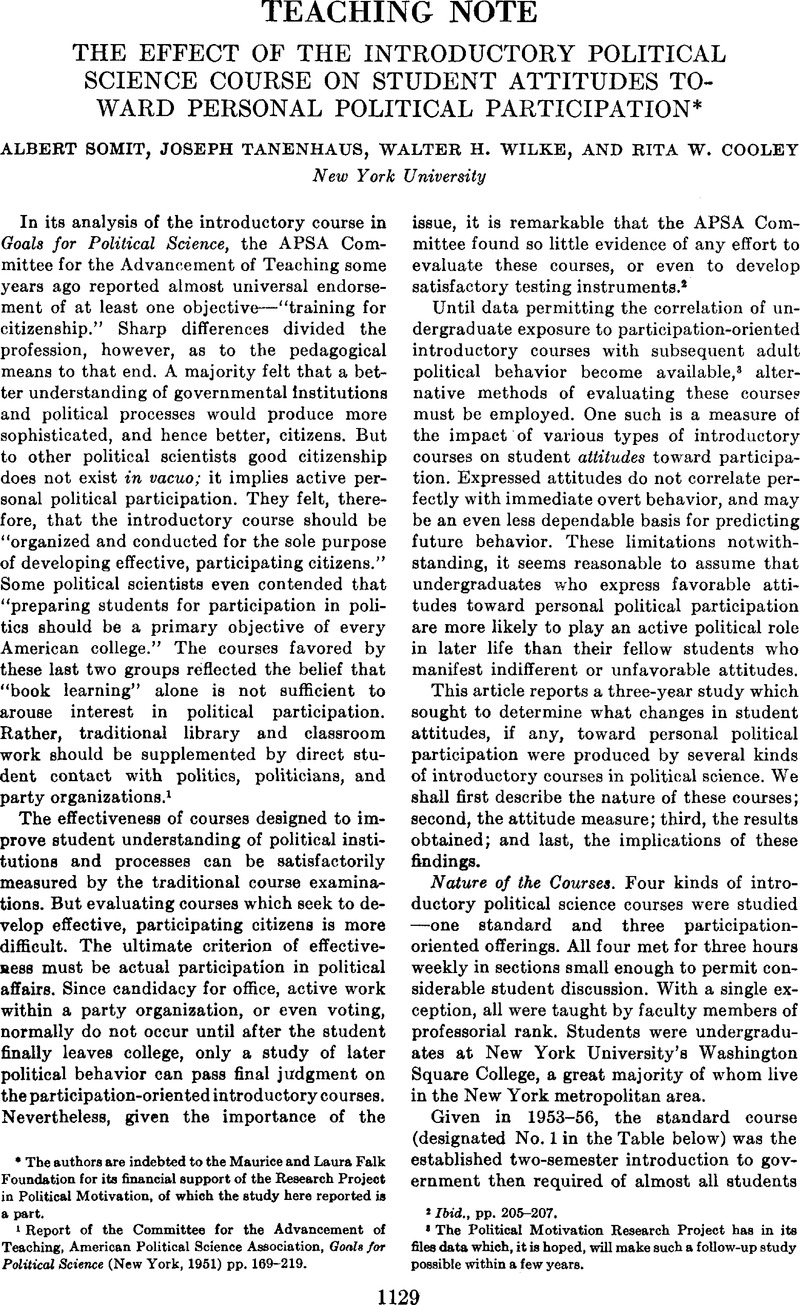Article contents
The Effect of the Introductory Political Science Course on Student Attitudes Toward Personal Political Participation*
Published online by Cambridge University Press: 02 September 2013
Abstract

- Type
- Teaching Note
- Information
- Copyright
- Copyright © American Political Science Association 1958
References
1 Report of the Committee for the Advancement of Teaching, American Political Science Association, Goals for Political Science (New York, 1951) pp. 169–219Google Scholar.
2 Ibid., pp. 205–207.
3 The Political Motivation Research Project has in its files data which, it is hoped, will make such a follow-up study possible within a few years.
4 The textbooks used in the standard course were Ferguson and McHenry, Roche and Stedman, and the volume of readings edited by Harvey, Skinner, Somit, and Nealon (brought up to date by more recent materials). Supplementary readings assigned by section leaders ranged from Barth, The Loyalty of Free Men, to Koestler, Darkness of Noon, and Orwell, 1984.
5 The text was Burns and Peltason. Additional readings were assigned from Riordon, Plunkitt of Tammany Hall, Lubell, The Future of American Politics, and the volume of readings by Bishop and Hendel.
6 Readings were drawn from Gettell, Political Science, Ebenstein, Man And The State, Appleby, Big Democracy, and Bishop and Hendel.
7 A somewhat similar scale was independently devised by the staff of the Ben A. Arneson Institute of Practical Politics at Ohio Wesleyan University in an attempt to measure the extent to which students' college experiences affect their attitudes toward practical politics. See Larson, Ruth M. and Mathews, Chester O., Changes in Students' Attitudes Toward Practical Politics Over a Four-Year Period (Delaware, Ohio, 1958)Google Scholar. None of the Institute's work seems directly comparable with the study here reported.
8 The Davis discrimination index is a linear scale from 0 to 100. See Davis, Frederick B., “Item Analysis Data: Their Computation, Interpretation, and Use in Test Construction,” Harvard Education Papers, No. 2 (Cambridge, 1946)Google Scholar.
9 The three scales used to measure (1) attitudes toward politicians, (2) interest in political news, and (3) attitudes toward personal political participation were largely independent instruments. Their intercorrelations, based on a sample of 354 students, were as follows: attitudes toward politicians and interest in political news (r =.141); attitudes toward politicians and attitudes toward personal political participation (r =.177); interest in political newB and attitudes toward personal political participation (r =.202). These results are not dissimilar to those in a recently reported study, where students at the University of Western Australia selected from a list of 84 adjectives best describing the politician the following five; ambitious, argumentative power-seeking, talkative, and evasive. See Walker, K. F., “A Study of Occupational Stereotypes,” Journal of Applied Psychology, Vol. 42 (1958), pp. 122–124CrossRefGoogle Scholar.
- 22
- Cited by





Comments
No Comments have been published for this article.